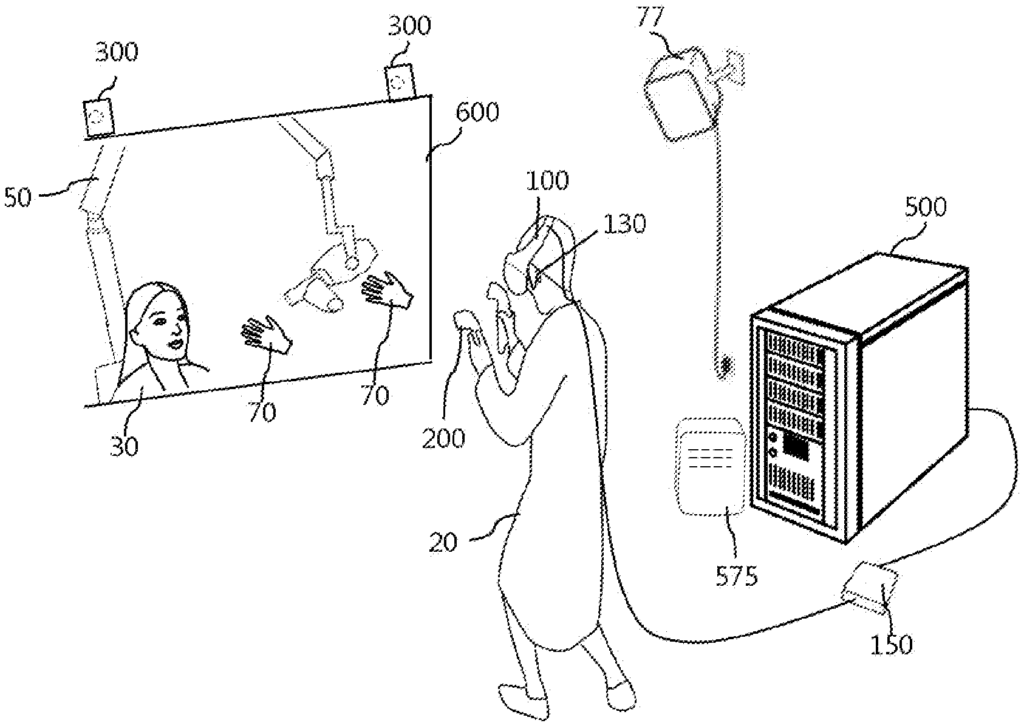Invented by Heasuk LEE, Eunil CHO, Vrad Inc
The Vrad Inc invention works as follows
The virtual radiology apparatus of this invention comprises a HMD, HMD Hand-mounted Unit, HMD Controller, and Main Server. It is described as follows: HMD Head-mounting Unit that is mounted to the head of a practitioner and outputs images with virtual radiography to the HMD Image Output Unit for virtual practice. HMD Hand-mounted Unit that is attached to the hands and contains the HMD Movement Detection unit that detects and records the movements of hands to manipulate virtual radiography on an image.
Background for Virtual Reality-based Radiology Practice Apparatus and Method
Radiation equipment can be dangerous to use because it exposes the user to radiation. Therefore, it is important to have highly trained personnel handle it.
There are many devices, such as a gamma-camera, a computerized tomographic camera, a thyroid measuring apparatus, an X ray device, a line accelerator, and a cyclotron. In many cases, even when dealing with the same type of radiation equipment, the method of handling it varies according to the manufacturer.
Future medical professionals should know as much about medical radiation equipment as possible, as it is directly related to a person’s life.
These medical radiation devices, however, are expensive and require a professional manager in order to be managed. It is difficult for schools and departments to acquire all this equipment.
Radiology practice was performed in schools and departments that needed radiology training using manikins or actual radiology equipment. The practitioners or educators could be exposed to radiation.
There is therefore a need for low-cost radiology equipment that allows the user to perform various tasks using different medical radiation equipment without any risk of radiation exposure.
The present invention is a virtual-reality radiology practice device.
It is impossible to be proficient in radiology practice by using virtual reality. This involves only seeing the equipment and not doing it.
It is therefore desirable to use the same virtual practice for the actual practice, where practitioners manipulate radiography equipment in order to obtain specific results through virtual reality.
The present invention is a virtual reality-based radiation practice apparatus and method where the practitioner is equipped with a HMD, wears a handheld unit on the hands, manipulates and performs virtual radiation practices in an audiovisual virtual reality environment, and the hand movement controller receives information from the hand mounted unit about the position and angle the hands are at, causes the virtual equipment to operate, and produces a specific virtual result as the virtual equipment is operated.
As a prior technology there is “System and Method for Virtual Reality Training for Odontology” In Korean Patent Laid Open Publication No. 2003-0044909.
As shown in FIG. The above prior invention is a virtual reality system that allows for procedural mobility. It senses the spatial position of an actual element that can be handled and held by hand. It displays a three-dimensional image of the virtual item (T) in the screen (7). The hand-held device (2) is part of the tactile human-machine interaction (IHM) (1), which has an actuator that can provide force feedback to a user holding the real element (2) when the virtual device interacts with the object virtual (T). The hand-held element (2) is a probe tool or similar device mounted at the end of the articulated arms (3) of the tactile device (1). This device provides force feedback to the user holding the actual element (2) as the virtual device interacts with the object virtual (T).
Korean Patent Publication No. The dental equipment 2003-0044909 is a device that allows dentists to practice without moving around, in one location, with a limited number of virtual patients and in an environment far removed from their actual practice environment.
The Korean Patent Laid Open Publication No. It is impossible to practice virtual radiation with different virtual patients and the equipment does not exist.
DISCLOSURE
Technical Problems
The present invention is aimed at solving the problem of providing a virtual reality-based radiation practice apparatus and method where the practitioner is equipped with a HMD, wears a handheld unit in their hands, manipulates and performs virtual radiation practices in an audiovisual virtual reality environment, the hand motion controller receives information from the handheld unit about the position and angle the hands are held in, and causes the virtual radiation equipment to operate. It then outputs specific virtual results as the virtual radiation equipment is operated.
The present invention also aims to solve the problem of providing a virtual reality based radiology practice apparatus that allows users to control virtual radiography equipment to match virtual patients of different types or virtual imaging objects, in virtual reality. It can also be used to verify virtual results.
The present invention also aims to solve another agenda by providing a virtual-reality-based radiology apparatus and method that can display images of a particular practitioner in virtual practice to an ordinary display, so that other practitioners or educators can see it.
Technical Solution
The virtual radiology apparatus of the invention is described as: “To solve the above agenda the virtual practice apparatus is characterized as comprising an HMD head mounting unit, a HMD handheld unit, a HMD control unit and a mainserver. It is further detailed as follows. The HMD handle-mounted is attached to the hands of a user and has the hand movements detection unit which detects hand movements of the user as they move their hands to manipulate the virtual equipment on the picture.
Click here to view the patent on Google Patents.
